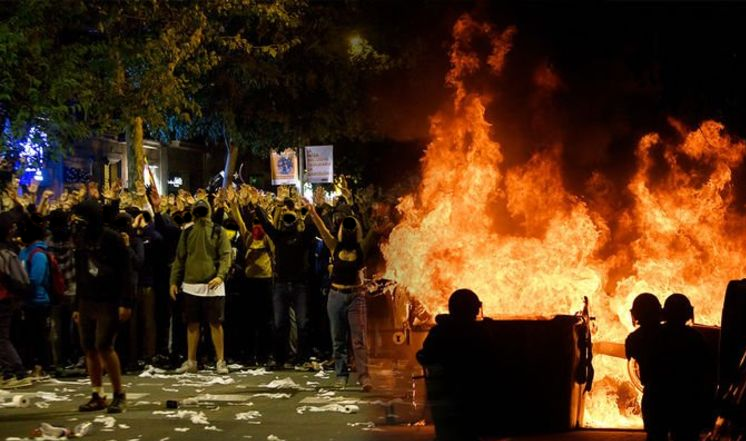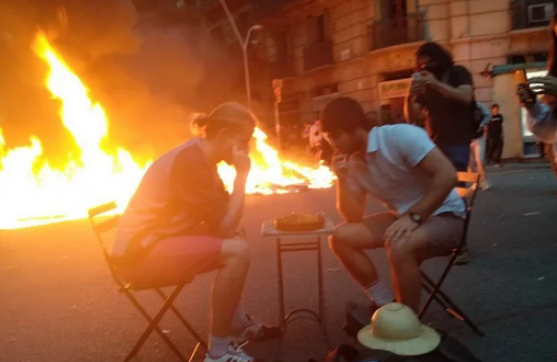It is we the workers who built these palaces and cities here in Spain and in America and everywhere. We, the workers, can build others to take their place. And better ones! We are not in the least afraid of ruins. We carry a new world here, in our hearts. That world is growing this minute.
Buenaventura Durruti

Right: Spanish riot cops behind burning garbage containers
On 14th October 2019, the supreme court of the Spanish state sentenced nine Catalan independence leaders to a combined total of 100 years in prison, for the crime of organising a democratic vote of self-determination. Within hours, a protest was launched at Barcelona’s airport, organised on an open-source mobile app called ‘Tsunami Democratic‘. Thousands of people shut down the airport, grounding flights and probably ruining many a tourist’s day. The police, as the violent enforcing arm of capitalism, charged at the protestors and beat them with batons, in an attempt to drive them away from the airport, immediately setting the tone on police response.
The protestors’ platform became one of non-violent civil disobedience, but the highly decentralised and non-hierarchical nature of this coordinated group accounted for a broad diversity of tactics. All around Catalonia, people called for the immediate release of these political prisoners, shouting “The streets will always be ours” as they demonstrated in their own communities, from city centers to rural villages. Police around the region responded to these peaceful protests with barbaric violence.
Police brutality is not unknown to Catalonia, which reacted in horror as the Spanish state’s national police force violently suppressed the 2017 independence referendum, attacking people in polling stations for daring to express their democratic will. But now 2 years later, Catalans watched as their own regional police force, the Mossos d’Esquadra, joined the national police in brutalising peaceful protestors with baton charges, rubber bullets and chemical weapons. Some protestors responded in the only way they knew how in the face of such brutality, by fighting back. This was now a fight in both meanings of the word, a fight for liberation not only against the Spanish state, but the collaborationist Catalan regional government that otherwise claimed to be on the side of those that wanted the right to self-determination.
The protests escalated into riots: barricades were formed from containers and trash cans, protestors hurled rocks and molotov cocktails at the police, and the people of Barcelona set their streets on fire. It was here that the protests first started to take a noticeable stance against both capital and the state. Anti-police, Anarchist and Communist symbols and slogans were painted on walls, people began chanting “A-Anti-Anticapitalista” and “Catalunya Antifascista”, some even took to destroying nearby bank offices and ATMs.

A general strike was called for the 18th October by Catalan trade unions. People blocked motorways as they converged from all of Catalonia’s major cities towards Barcelona. Hundreds of flights into and out of Catalonia were cancelled. Buses, trains and metro lines were reduced to 1/3rd their usual capacity. Electricity consumption dropped by 1/10th. The manufacturing of cars in the town of Martorell was brought to a complete halt. Tourists were horrified as all the posh shops in the center of Barcelona kicked them out and pulled down their shutters, while locals marveled at the literal breath of fresh air brought about by the removal of cars from public spaces.
In this huge display of workers’ solidarity, direct action and self-direction, the people of Catalonia accomplished in one day what took reformist politicians years. This shows just how powerful a popular social movement can be in affecting change, not only to a social and political landscape, but to the climate too. At a time flash flooding is decimating large portions of the Levante (Eastern Iberia), the need for that revolutionary social change is more pressing than ever.
With this increased intensity of non-violent resistance, came an increased intensity of violent police repression. The Spanish state’s national police and Mossos alike were filmed savagely beating people, throwing tear gas from rooftops, driving their vans at high-speed directly at blocs of peaceful protestors, and shooting rubber bullets at random passers-by, all without any provocation. In this state of absolute upheaval, the Mossos even finally got to use the water cannon that they bought from the Israeli state in 1994. When violence was initiated, it was done so by the police, these protests continuously prove to be extremely peaceful so long as there is little-to-no police presence.
All this brutality was ignored by the Spanish state’s caretaker president Pedro Sánchez, who engaged in a stunning display of whataboutism by pointing the finger at the “violent protestors”. He continuously moved goalposts for the Catalan region’s caretaker president Quim Torra, claiming the pro-independence leader “wasn’t condemning the violent protests enough”, in spite of the fact Torra was also pointing the finger at “violent protestors” and was the one that sent the Mossos to put down the protests in the first place.
I don’t agree with violence, but there is a point where the “smiling war” no longer works. I believe there is a point at which it’s no longer violence, but self-defense. In fact, if a barricade is made, if I need to make one so that nothing happens to me, to the people I love or to anyone else, I will, be it burning containers, be it burning whatever needs to be burnt.
Anonymous Catalan Protestor
The forces of the Spanish state and the opportunistic Catalan government are already attempting to divide and conquer the protestors, by driving a wedge between those protestors that are “violent” and “non-violent”, when they themselves made it clear that they do not recognise the distinction anyway.
This kind of Orwellian doublethink is indicative of a much deeper problem with the Spanish state, that this constitutional monarchy is fundamentally the successor to a fascist regime. Fascism is still very much alive today in the Spanish state. Earlier this year we saw a new fascist party taking seats in the Spanish state’s chamber of deputies. The protests brought about a rallying of Spanish fascists against Catalonia’s cry for self-determination. This has ranged from fascists egging on or working directly with the police, others forming vigilante squads to attack protestors in the streets, to some advocating for imposition of martial law and even planning a mass mobilisation.
But the people of Catalonia will not be silenced and put down, they continue to resist the forces of capital, the state and its tool of self-preservation: fascism.

They demand:
- Amnesty: Releasing of all political prisoners and safe returning of exiles.
- Liberty: Guaranteeing citizens the human right to self-determination.
- Security: Ending police brutality and disarming them of chemical weapons.
Els carrers seran sempre nostres, fora a les forces d’occupació!
Read More:
- ‘Tsunami of dissent floods streets of Catalonia’ by Bue Rübner Hansen
- ‘Catalunya: A Week of Escalation’ by Crimethinc
- ‘The Fight in Catalunya: Independence or Self-Determination?’ by Crimethinc
- ‘Statement regarding the current situation in Catalonia’ by CNT Catalonia
This article was written by a Green Anarchist comrade on the ground in Barcelona
